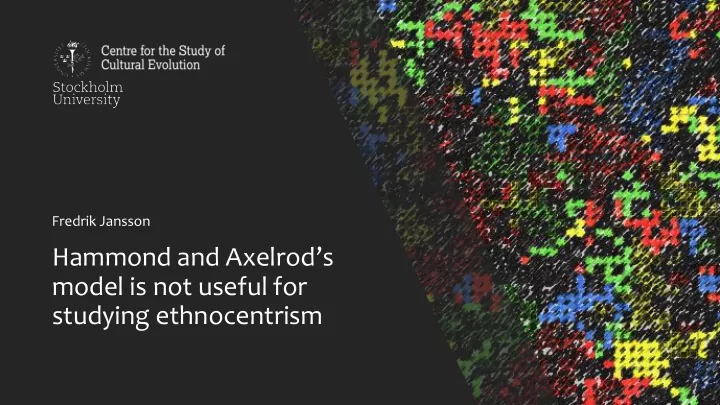

Fredrik Jansson Hammond and Axelrod’s model is not useful for studying ethnocentrism
The Segregation Model Schelling 1971 ncase.me/polygons
The Segregation Model
The Segregation Model
The Dissemination of Culture Model Axelrod 1997
The Ethnocentrism Model Hammond and Axelrod 2006 Outgroup Ingroup
Ethnocentrism Oxford English Dictionary ethnocentric, adj. Pronunciation: Brit. / ˌɛθnə(ʊ)ˈsɛntrɪk /, U.S. / ˌɛθnoʊˈsɛntrɪk / Origin: Formed within English, by compounding. Etymons: ETHNO - comb. form , - CENTRIC comb. form . Etymology: < ETHNO - comb. form + - CENTRIC comb. form . Tending to view the world from the perspective of one's own culture, sometimes with an assumption of superiority; limited as regards knowledge and appreciation of other cultures and communities. Also in neutral sense: aware of membership of an ethnic group, community, or culture. Ethnocentrism Ingroup bias Tag-based co-operation
Mechanisms and outcomes Schelling Axelrod Hammond & Axelrod Moderate preferences Local convergence Clonal interaction for homogeneity Segregation Global polarisation Tag-based co-operation
The prisoners’ dilemma The If you help me, then I benefit more common than it costs you to help good … If I help you, then you benefit more than it costs me to help The commonly best outcome is if we help each other …conflicts No matter what you do, I benefit from with self not helping you interest No matter what I do, you benefit from not helping me In the end, we are not going to help each other
Tag-based co-operation • People co-operate with members of the same group • And discriminate against members of other groups • Groups can be recognised by markers or tags • Kinship co-operation is well understood • Adaptive: Your gene helps itself • The challenge is to explain tag-based co-operation among nonkin • In a nonreciprocal environment, e.g. among strangers
Different interpretations of the same model The armpit effect Ethnocentrism
The crux of the matter • Co-operation in a one- shot prisoners’ dilemma is inherently incompatible with increased fitness • The model needs to make additional assumptions for tag-based (or any) co-operation to evolve • These additional assumptions are by necessity driving the results • Do assumptions related to the armpit effect carry over to explain discriminative co-operation between people?
Main assumption: neighbouring offspring on a lattice • Share of co-operators with no tags • No spatial structure: 3% • Lattice structure: 80% • Share of strategies with four tags • A spatial structure is necessary and the lattice structure is sufficient for co-operation DD DC CD CC No spatial structure 86 3 10 1 Lattice structure 8 2 76 14
Main assumption: neighbouring offspring on a lattice • The assumption makes co-operation adaptive • New target strategy: tag-based defection
Tags show common descent Same tag Different tag Common descent 71 4 Different descent 9 17 • P(common descent | same tag) = 0.89 • P(same tag | common descent) = 0.95
Conclusions so far • Neighbours are clones, sharing marker and strategy • This is an unsound assumption for ethnocentrism • It this assumption driving the results? • Can the assumptions be relaxed?
Other spatial structures Similar with close to regular networks Optimum: 4 – 6 Max: ~14 Non-spatial assortment
Markers of common descent • Kin identification cannot fail too often • A large tag mutation • Failure to co-operate in every other interaction • The more tags, the more successful is ‘ethnocentrism’ • ‘Ethnocentrism’ can be invaded by kin identifiers
Conclusions • The model illustrates the evolution of tag-based defection towards non-clones • Useful generalisations are not likely • Sensitive assumptions • a small neighbourhood • interactions mostly with clones • a copying process that is not too erroneous
Potential application
Future directions • The spatial structure is a way of changing the strategic structure • from a one- shot prisoners’ dilemma to some other game • More straightforward and transparent question: • Which underlying strategic structures lead to tag-based co-operation? • New model • Random interactions • The game is a free parameter
Games of co-operation • Prisoners’ dilemma – Whatever you do, I will defect • Harmony – Whatever you do, I will cooperate C D C D C + -- C + + D ++ - D - -
Games of co-ordination • Co-ordination – (Oh, oobee doo) I wanna be like you • Anti-co-ordination – I want to do the opposite of what you do A B A B A + - A - + B - + B + -
Specific games of co-ordination • Stag hunt – Rowing a boat • Hawk-dove – Cycling a tandem bike A B A B A 2 -1 A 2 1 B 0 0 B 3 0
Tag-based co-operation in different games
Further reading
Recommend
More recommend